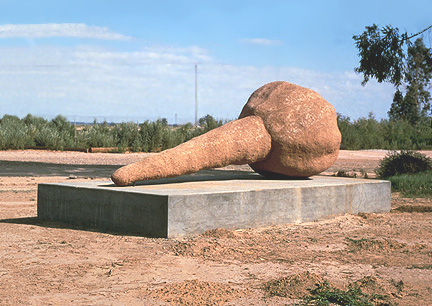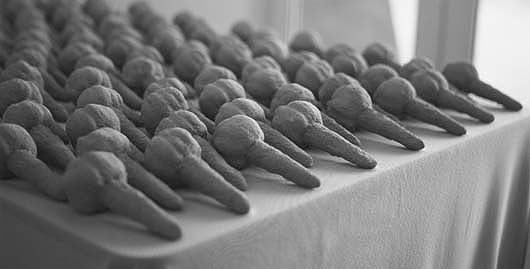Visit:
Allan McCollum. Large Model of a Sand Spike, for the Imperial Valley. 2000. Concrete and sand. Installation: The Imperial County Pioneer Museum, Imperial, California.
(en Español)
SIGNS OF THE IMPERIAL VALLEY
Sand Spikes from Mount Signal
A project by Allan McCollumDinosaur tracks in the roofs of Utah coal mines, fulgurites
* from central Florida, a dog's form captured in the hardened ash of Pompeii—all have been subjects of Allan McCollum’s work, and vehicles for his investigation of the phenomenon by which objects, including artworks, acquire meaning. Born in Los Angeles in 1944 and currently living in New York City, McCollum is interested in the process that bestows value on “things,” both natural and manmade. His current project, commissioned by inSITE2000, extends his study of an object’s accumulation of meaning to include a community’s construction of its public identity. McCollum suggests that the way an artist develops meaning in his or her artwork parallels the procedure by which individuals and groups establish communal significance. At the same time, an artist seeking recognition by curators, collectors, dealers, critics and viewers is seen by McCollum as participating in the same quest as a community striving to project a winning image to the society-at-large.
Allan McCollum. Sand Spike Souvenirs for the Imperial Valley. 2000. Plaster, white glue, and sand from Mount Signal. Installation: The Steppling Art gallery, San Diego State University, Imperial Valley campus, Calexico, CaliforniaMcCollum’s joint examination of the ways in which both objects and communities accrue cultural importance was pursued in the Imperial Valley/Valle de Mexicali, an expansive desert region east of San Diego County and spanning the U.S./Mexico border. The artist was drawn to this area for two reasons. First, he was inspired by the strange geological formations, known as sand spikes, found at the base of Mount Signal/El Centinela, a prominent feature of the area’s landscape that itself straddles the international boundary line. Thousands of these ancient sand spikes were formed as concretions—grains of sand cemented together with crystalline calcite—and lay together at the foot of the mountain, pointing westward, until they were excessively collected throughout the 20th century. Today the sand spikes can only be found in museums and private collections.
The second allure of the desert valley for McCollum was the youth of its towns and cities. The region’s burgeoning municipalities, such as Brawley, Calexico, Calipatria, El Centro, Heber, Holtville, Imperial, Mexicali, Niland, Seeley and Westmorland, were established in the early 20th century, coincident with a major irrigation project that brought water to the desert. Because these relatively new communities are still in the process of developing their identity, McCollum perceived an opportunity to contribute, in some small way, to the region’s formation of its cultural iconography through collaboration with the individuals, institutions and businesses that inhabit the Imperial Valley/Valle de Mexicali.
Allan McCollum. Large Model of Mount Signal, for the Imperial Valley. 2000. Mixed media. Fabricated by Allan McCollum and the Museo Universitario, Universidad Autónoma de Baja California. Installation: Museo Universitario, Universidad Autónoma de Baja California, Mexicali, Mexico.The result of McCollum’s collaborative involvement with the valley’s residents was the organization of three exhibitions that focused on the sand spikes of Mount Signal/El Centinela. Through these exhibitions, presented concurrently at three area institutions in October 2000, the artist conjoined his simultaneous exploration of the evolution of meaning in artworks, natural objects and communities. Signs of Mount Signal at the Steppling Art Gallery, San Diego State University—Imperial Valley Campus; The Return of the Sand Spikes at the Imperial County Historical Society Pioneers Museum; and El Cerro Impossible at the Museo Universitario, Universidad Autónoma de Baja California each featured a variety of art and artifacts related to the region and assembled through a concerted community effort.
Allan McCollum. Mount Signal Souvenirs for the Imperial Valley. 2000. Plaster, latex paint. Installation: The Steppling Art gallery, San Diego State University, Imperial Valley campus, Calexico, CaliforniaFor the exhibitions, McCollum played a dual role as curator and artist. He invited local artists in the Imperial Valley/Valle de Mexicali to exhibit drawings, paintings and photographs appropriate to the exhibitions’ theme; he included regional memorabilia, area postcards, and logos from valley businesses and institutions; and he featured actual sand spikes from his and others’ collections. In addition, McCollum produced and displayed over one thousand replicas of a sand spike from the Pioneers Museum collection and an equal number of small models of Mount Signal/El Centinela. He also oversaw the construction and installation of a sixteen-foot version of the sand spike and a large model of the mountain. Lastly, McCollum created a set of sixteen informational booklets that were derived from historical and scientific articles on sand spikes and the mountain.
McCollum has combined the three exhibitions at the University Art Gallery. This culminating presentation celebrates the Imperial Valley/Valle de Mexicali community’s affection for its local mountain and raises awareness of the community itself in people from outside the area. Importantly, the sand spike and mountain replicas, created to function as souvenirs for the region, are intended to promote the natural and cultural features of the valley for years to come. And after its appearance in San Diego, the large sand spike will be permanently installed as an outdoor, site-specific sculpture and “roadside attraction” on the grounds of the Pioneers Museum. Through his complex project, McCollum has created memorials to the valley’s geological past, while participating as an interested outsider in the ongoing development of its residents’ collective identity.
Tina Yapelli
Director, University Art Gallery
San Diego State University,
San Diego, California
A fulgurite is a glass-like tube produced by the fusion of loose sand or rock by lightning.
*
Imperial Valley
Concretions
Mount Signal
Poems and Stories
Images of
Mount Signal/El Centinela
 HOME
HOME



